If you are an avid cook, you may already know that Japanese knives are of the highest quality. These utensils are the most popular among professional chefs around the world, and the number of users of this type of knives has increased considerably in recent years. Would you like to make good cuts with the best Japanese knives? Our guide is for you.
Here is our commitment, to make sure that we provide the best user experience and content quality:
You can support us by using our links to make your purchases (at no extra cost to you)! This sometimes earns us a commission which allows us to remain independent. More about us
Our selection
"This Santoku SHAN ZU has a stainless steel blade that makes it durable and resistant to wear. Lightweight, sharp and ultra-thin, it helps you perfectly…"
"The stainless steel blade of this Nakiri Japanese knife guarantees a better cutting power. Its high quality plastic handle offers you a pleasant grip."
"Ultra sharp and resistant, this Japanese knife has been forged in 67 layers of Damascus steel in pure respect of the traditional Japanese cutlery. It…"
"Featuring a shimmering blade, this Japanese knife has been forged from 67-layer Damascus stainless steel. It is non-stick, tough and resistant to oxidation."
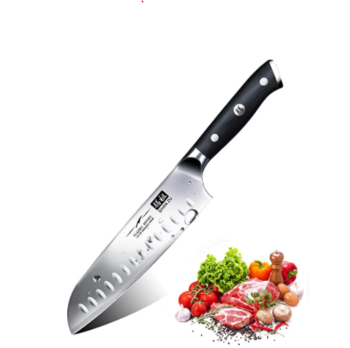
This Santoku SHAN ZU has a stainless steel blade that makes it durable and resistant to wear. Lightweight, sharp and ultra-thin, it helps you perfectly cut your meats, vegetables and fruits.
See the offerMade mostly of high quality stainless steel, this Japanese general purpose Santoku knife offers good resistance and exceptional durability. Indeed, the carbon content of its blade is high enough to allow it to be very rigid and insensitive to rust, corrosion and wear. The thickness of its blade is only 2 mm and its cutting edge is ultra thin. It will finely and neatly cut your vegetables, meats and fruits.
Its blade measures 18 cm and can easily cut large fruits such as watermelon and cantaloupe. Cutting will be easy too thanks to its light weight. The handle of this Santoku is made of high quality wood. It is suitable for both right and left handed people, regardless of the size of the hand. In short, this Santoku SHAN ZU Japanese knife is absolutely what you need if you are a cooking enthusiast.
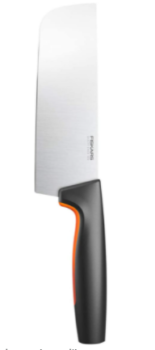
The stainless steel blade of this Nakiri Japanese knife guarantees a better cutting power. Its high quality plastic handle offers you a pleasant grip.
See the offerThis is a Japanese knife with a rectangular blade used in the preparation of vegetables. It is also the ideal kitchen knife for peeling and preparing fruits or for cutting herbs. This model offers great cutting power thanks to its extremely sharp Japanese stainless steel blade. The blade has a length of 16 cm.
The ergonomic handle is made of high-quality plastic and is not easily damaged. The bottom surface is made of a soft touch material and provides a good grip. In addition, it promises a high level of safety and convenience with its finger guard.

Ultra sharp and resistant, this Japanese knife has been forged in 67 layers of Damascus steel in pure respect of the traditional Japanese cutlery. It is a luxurious Japanese knife.
See the offerThis Japanese knife from Jikko is a Gyuto (a Japanese chef's knife). It was made in the pure Japanese tradition and its blade was forged in 67 layers of Damascus steel HRC60. This steel has an excellent reputation for sharpness. Its resistance is unmatched and has nothing to envy with classic industrial steels.
The handle of this Japanese knife is cylindrical and carved from maple wood, then meticulously polished. It is both luxurious and ergonomic. Unlike the blades of western knives which have an angle of 20°, the blade of this Japanese knife is only 15°. This allows it to slice very efficiently and quickly. You will have no trouble slicing even the hardest foods, without even having to force them.

Featuring a shimmering blade, this Japanese knife has been forged from 67-layer Damascus stainless steel. It is non-stick, tough and resistant to oxidation.
See the offerMade of 67-layer Damascus stainless steel, this Japanese Santoku knife has a mirror-like blade. The steel gives it a strong tenacity and a good resistance to oxidation. It has a sharpness 4 times higher than a normal steel knife. Its handle is made of G10, a material that resists humidity and all weather conditions. Moreover, its grip is very comfortable.
The length of the blade of this Japanese knife is 20 cm, the thickness is 2 mm. Thus, it allows you to cut faster. Moreover, the slicing and cutting is very precise; the sliced food will never be torn. The blade is also non-stick and has a fantastic pattern. It will always keep its color.
Any specific needs?
The best Japanese knife in 2021
The best entry-level Japanese knife
The best high-end Japanese knife
The best Japanese chef's knife
Your guide :
Rate this buying guide :By rating this buying guide, you are helping us to reward our best writers. Thank you!
| TOP OF THE TOP | CHEAP | TOP OF THE LINE | EXCELLENT | |

In accordance with our commitment, this buying guide does not contain any sponsored products. |
 9/10 |
 7/10 |
 10/10 |
 8/10 |
| OUR SELECTION |
Santoku japanese knife SHAN ZU
|
Fiskars Nakiri Japanese knife
|
Jikko Japanese knife
|
Damascus Chef's knife
|
|
This Santoku SHAN ZU has a stainless steel blade that makes it durable and resistant to wear. Lightweight, sharp and ultra-thin, it helps you perfectly cut your meats, vegetables and fruits.
|
The stainless steel blade of this Nakiri Japanese knife guarantees a better cutting power. Its high quality plastic handle offers you a pleasant grip.
|
Ultra sharp and resistant, this Japanese knife has been forged in 67 layers of Damascus steel in pure respect of the traditional Japanese cutlery. It is a luxurious Japanese knife.
|
Featuring a shimmering blade, this Japanese knife has been forged from 67-layer Damascus stainless steel. It is non-stick, tough and resistant to oxidation.
|
|
|
Dimensions
|
31.7 x 4.5 x 0.2 cm
|
28.3 x 5.5 x 2.4 cm
|
33 x 4 x 4 cm
|
34 x 0.3 x 4.6 cm
|
|
Blade length
|
18 cm
|
16 cm
|
20 cm
|
Alloy steel
|
|
Blade material
|
Martensitic stainless steel
|
Stainless steel
|
Damascus steel
|
Damascus steel
|
|
Handle material
|
Pakka wood
|
Plastic
|
Maple wood
|
G10 (a heat and cold resistant, waterproof and non-slip military material)
|
|
Solidity
|
|
|
|
|
Help us improve this table:
Report an error, request the addition of a feature to the table, or suggest another product. Thank you for your kindness!
We spend thousands of hours each year studying the major specialized websites, analyzing products of hundreds of brands and reading user feedback to advise you on the best products.
We are a product review company with a single mission: to simplify your buying decisions. Our research and testing helps millions of people every year find the best products for their personal needs and budget.
To support us you can: use our links to make your purchases (which often earns us a small commission), share our articles on social networks, or recommend our site on your blog. Thanks in advance for your support!

Before investing in a Japanese knife, it is important to think about the main use you will make of it, because they all have different functions. For example, if you want to cut vegetables, meat and fish fillets with one versatile knife, you will probably need a Santoku Japanese knife.
In addition to the Santoku, the most commonly used knives in Japanese cooking are the following:
The blade of a Japanese knife can be symmetrical. This means that its edge is V-shaped, like that of a classic knife. It presses on both parts of the food when cutting. As a result, the food can be damaged. On the other hand, some Japanese knives have an asymmetrical blade, which means that it is sharpened only on one side. The edge is beveled so as not to alter the flavor of the food to be cut, as the juice does not run out. This shape also allows a very fine and clean cut. Japanese knives with such a blade are mainly the Deba, the Usuba, and the Yanagiba.
The material with which the Japanese knife blade is made defines its durability. It can be Damascus steel, ceramic, or carbon steel. The Damascus steel blade is made of many layers of steel forged together. It is highly resistant to rust and has excellent slicing ability. In addition, it requires less regular maintenance. Knives with this type of material are reliable and aesthetically pleasing. They are also the most prestigious.
For good cutting qualities and to ensure more convenience, the handle of a Japanese knife should offer you a comfortable grip. This mainly depends on the material of the handle. If it is made of wood, make sure it is rot-proof or treated for durability. For metal, stainless steel is best. Finally, if it is made of plastic, choose the one that is of high quality, because this synthetic material is easily damaged if it is of low quality.
Like any kitchen utensil, a Japanese knife also needs maintenance. It is even essential to keep it sharp. The ideal way to preserve its lifespan is to maintain it properly by doing a good washing, to take care of its cutting surfaces, to sharpen it and to store it well.

The Japanese knife cleaning
Whether your Japanese knife is made of stainless steel or carbon, it is absolutely necessary to make a habit of cleaning it. That is, after each use, you should absolutely wash it with a soapy sponge and dry it properly. Indeed, you should not dry your Japanese knife in the open air, because it may rust. It may also rust if the stainless steel is left wet for too long.
Also avoid using abrasive materials like metal sponges, as they can scratch it fiercely. Using a harsh detergent or dishwashing liquid can also damage the handle and edge. However, the plastic abrasive side on the sponge is suitable for most Japanese knives, but it can also take away its shiny appearance.
Checking the cutting surface
The quality of the cutting board or plank is very important. Indeed, your Japanese knife should bite into the board slightly. If the material of the board is too hard, the Japanese knife will dull very quickly. It is therefore recommended to use a wooden or plastic board. These preserve the quality of your knife.
Sharpening a Japanese knife
A sharpener is essential to keep your Japanese knife always sharp. To do this, you can use a whetstone, sharpening gun or electric sharpener.
Storing a Japanese knife
Storing your Japanese knife in a drawer full of other utensils can damage it.
So, be sure to place it on a secure spot, on a magnetic bar or in a knife block, for example. In case you run out of space to store it, cover it with a plastic blade guard before placing it with other tools.
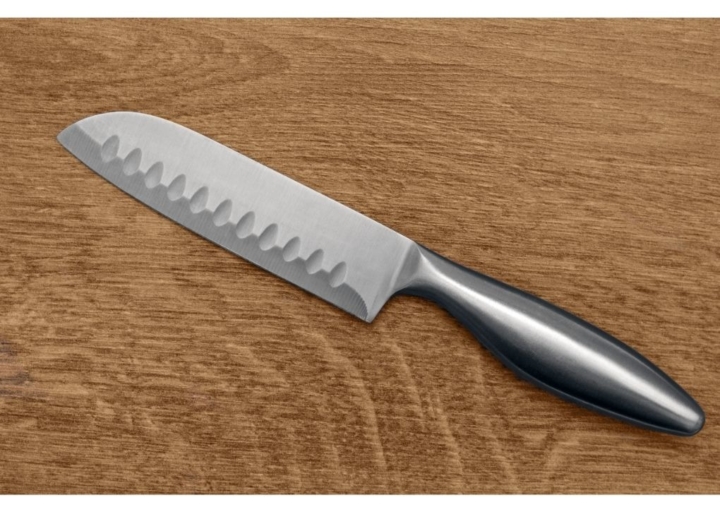
Among the types of Japanese knives, the Santoku is the most widespread on the market. Characterized by a light and curved blade, it is quite versatile, as it has 3 functions: cutting, slicing and chopping. Its meaning is "three good things". Practical for slicing through fish, vegetables..., it offers a swinging effect due to its slightly curved blade.

Also called sashimi knife, the Yanagiba is dedicated to sushi cuts. With its blade that is long, sharp, thin and rigid at the same time, it looks like a Japanese sword. Its thinness allows to remove easily the skin of the fish. The length of a Yanagiba helps to have more precision in slicing. This makes it indispensable for sushi lovers.

A Deba is a short and strong Japanese kitchen knife. It is used to lift fish and shellfish fillets. Easy to recognize by its curved back, it is also marked by a thick blade that is designed to resist many edges. But, most of these types of knives are not suitable for left-handed people.

As for the Gyuto, it is a knife primarily designed for cutting beef or large vegetables. It has a flatter blade to provide cutting power. The length of its blade is usually 21 or 27 cm. The one that is 21 cm is easier to handle while the one that is 27 cm is more versatile in cutting.

This is the traditional Japanese knife, used only for preparing vegetables. With a rectangular shape and a heavier blade, slicing herbs, carrots, cabbage with the Nakiri will be like a child's play. Moreover, its rectangular shape allows to move the cut vegetables to a container.
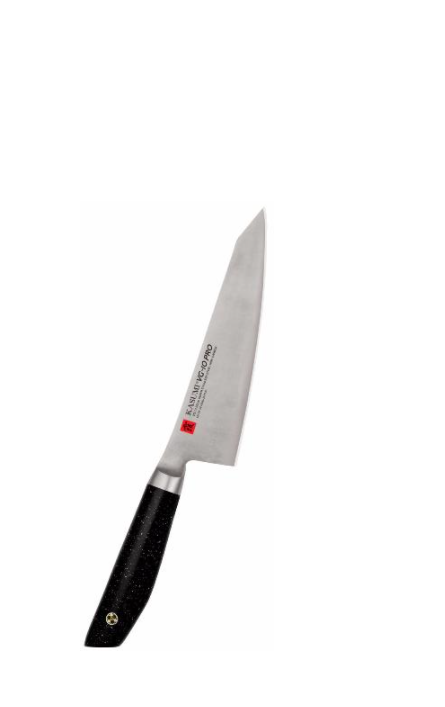
It is a Japanese knife used for boning. Very rigid, its blade is triangular in shape. What differentiates it from Western boning knives is that it offers more precise boning due to its rigidity. It is perfect for poultry because it has an asymmetrical edge. However, it also exists in models with two sharp edges.
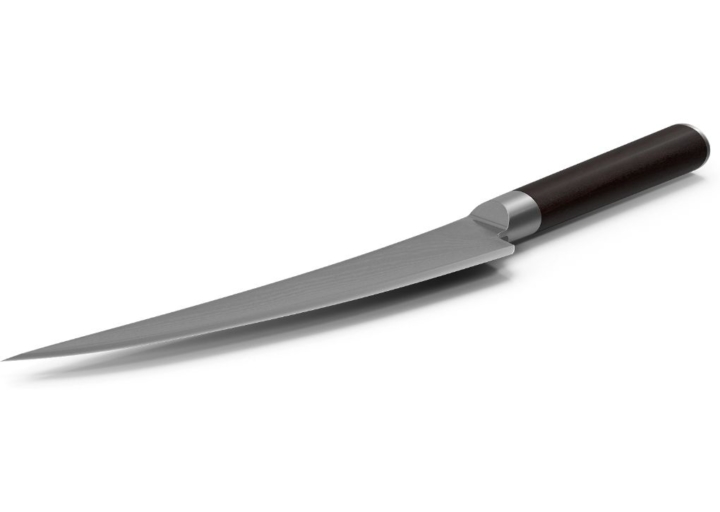
Generally called a slicing knife, this Japanese knife is used in cutting large pieces of meat. It can slice more straight in one pass with its blade is long and smooth.
Reputed to be the sharpest in the world, Japanese knives are forged from very hard steel. Their hardness often exceeds 58 HCE and offers a more precise cut. The advantage with this type of knife is that it is also light and thin. In addition, their cutting edges stay sharp longer.
However, the nature of its steel also has some drawbacks. Due to its rigidity, the blade becomes less flexible. This lack of flexibility makes it easy to break if mishandled. The blade is also more difficult to sharpen. Moreover, a certain expertise and appropriate equipment (ceramic sharpening gun for example) are necessary to sharpen it.
The steel with which French knives are made is less hard. Their flexibility is therefore their greatest asset. The back of their blades is thicker and becomes less thin as it goes towards the cutting edge. This characteristic allows them to be more robust. They are versatile and can be used to cut both hard and soft foods without worrying about the edge being damaged.
On the other hand, French knives are easier to sharpen due to their less rigid blades. But their cutting power is weaker compared to Japanese knives. In addition, they dull much faster and therefore need to be sharpened from time to time. Their cutting quality is also less satisfactory.
If you are looking for a sturdy knife that can cut through bones and other hard parts of a food, look for a French knife. However, if you are looking for a razor-sharp knife that can finely slice food, go for a Japanese knife.
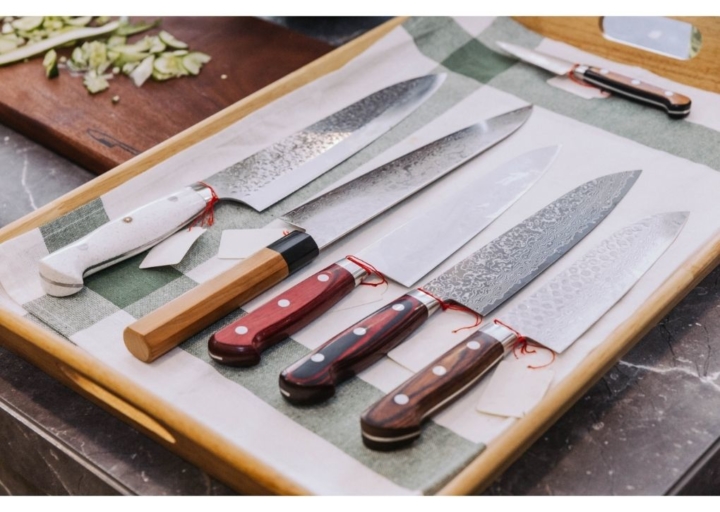
For its thinness and lightness
If you choose other knives or choppers, their heaviness makes cutting difficult. The lightness of a Japanese knife, on the other hand, helps you not to lose your energy and to cut easily and quickly your food. Its blade is also very thin and allows you to have a very thin slice.
For its high quality steel blade
Most Japanese knife models use high carbon steel. They are often combined with additional elements to improve their strength, such as nickel, chromium, vanadium, tungsten, molybdenum.
It's an ultra sharp and durable knife
When you are looking to invest on other kitchen knives, you need to check their cutting edges so you don't have to sharpen every day. On the other hand, the edges of Japanese knives are more durable and require little sharpening because they are made from a harder, ultra-strong steel.
For its very elegant design
The design of a Japanese knife is so meticulous that it invites you to use it daily. It gives you the desire to always cook. Indeed, its blade is often decorated with beautiful patterns and sometimes, mirrored. Its handle is also very elegant (made of precious wood, G10, etc.) and more ergonomic than those of western knives.
For more efficient cutting
The cutting movements of a Japanese knife must be done from top to bottom. It is a bit unusual, but with time and practice, this cutting technique allows you to cut with more speed and efficiency.
In our opinion, the best brands of Japanese knives in 2022 are :
This Japanese brand is already very popular in the cutlery world, even though it was only established in 2016. Indeed, its reputation is due to its first knife model: the VG10 Damascus Japanese chef's knife. Shan Zu brand Japanese knives are reliable, ultra-sharp and have a good price/quality ratio.
Jikko is a Japanese company based in Osaka, Japan. It has over 100 years of expertise and its knives are used by over 100,000 chefs around the world. The brand's knives are individually forged by experienced craftsmen, using its unique "Hatsuke" technique to have a balanced, uniform edge that stays sharp for a long time.
Founded in 1649, Fiskars is the oldest Finnish company. This international group specializes in designing tools for manual use. In addition to being comfortable and stylish, its Japanese knives also stand the test of time.
This Japanese company also boasts over a century of experience in cutlery. These knives are of high quality and have been hand-forged following the ancient methods of Katana's master blacksmiths.
In its early days, in the 1950s, this Japanese brand made sharp tools for agriculture. It then turned to the design of kitchen knives and became one of the most renowned brands in the world. These kitchen knives are top-of-the-line and have a formidable cutting power.
The diagram below will help you to get an idea of the typical prices for each price range (entry-level, mid-range and high-end).
However, more expensive does not necessarily mean better.
We therefore advise you to always consult our ranking before deciding, rather than blindly relying on price ranges.
Apply oil to your Japanese knife
Even though it is made from the finest steels, the smallest amount of moisture in the air can cause rust to form on the blade of a Japanese knife. The best way to avoid this is to apply oil to the blade every few weeks.
Don't put your Japanese knife in the dishwasher
All Japanese knives should be washed immediately by hand after use, and with a mild detergent. Putting them in the dishwasher can damage their cutting edges, changes the chemistry of their material and will rust them.
Avoid cutting on hard surfaces with your Japanese knife
If you are used to cutting directly on hard surfaces such as a work surface like the sink, ceramic cutting board, bamboo, corian or other hard materials, it can easily dull your Japanese knife. So it is better to use a wooden or soft plastic cutting board.
Protect the blade of your Japanese knife.
The thing you should do to preserve the quality of your Japanese knife blade is to avoid cold. That is, cold temperature makes the steel more brittle and fragile, like frozen food. So get in the habit of defrosting food that comes out of your refrigerator before cutting it with a Japanese knife.
You can repair the handle of your Japanese knife.
The wooden handle of Japanese knives can shift out of place. This can be a little more difficult to fix, but you can use strong glue to fix it again. Just apply it and let it sit for a few hours before using the knife again.
The easiest way tosharpen your Japanese knife is to follow these steps
First of all, the all-purpose Japanese knives are the Santoku and the Gyuto. While the Deba is used to cut or prepare fish. For carving meat, the most suitable is the Sujihiki. The Honesuki is used to prepare and debone poultry carcasses. The Maguro is used to prepare large meat or fish. When it comes to slicing sushi or lifting fillets, nothing replaces the efficiency of sashimi knives.
Presumably all Japanese knives are used by simply pressing on the food to be cut. This makes for a perfect cut because of their rigid blade. But you need to make a rocking motion when chopping meats to avoid damaging the edge.
Compared to other types of knives, Japanese knives are lighter and sharper. This makes them very comfortable to handle. Their steel is harder and their blades are thinner. These are exactly the main reasons why Japanese knives deserve to be preferred.
Every month we help more than 1 000 000 people buy better and smarter.
Copyright © 2022 - Made with ♥ by buyingbetter.co.uk
Your reviews and buying guides 0% advertising, 100% independent!